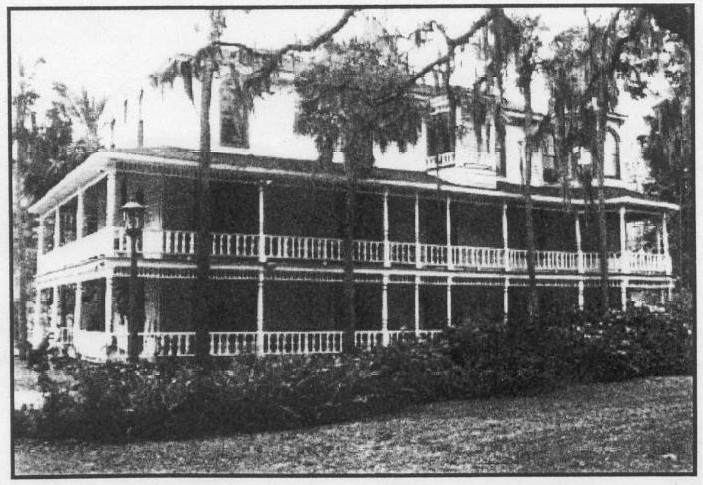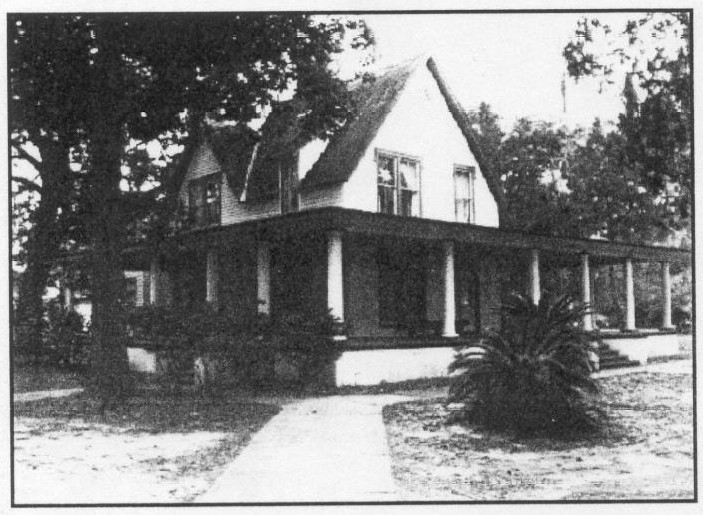
Marabanong, 4749 River Point Road, circa 1876.

Marabanong, 4749 River Point Road, circa 1876.
The 1876 Philadelphia Centennial Exposition,
which displayed examples of colonial buildings, evoked interest in the
Queen Anne style, especially in the design of country houses. Thomas Basnett,
an English astronomer of considerable reputation, probably derived his
plans for a house from the exposition, for in that same year he began construction
at Empire Point of an elaborate Queen Anne residence, which he placed on
a promontory overlooking the St. Johns River about a half-mile south of
Diven's house. The property had been owned before the Civil War by Thomas
Perley, who dug a wine cellar into the bluff below the house. It alone
survived a fire that destroyed the Perley residence. Basnett's house featured
a two-story veranda replete with lathe-turned posts and spindles encircling
a 6,000-square-foot building. Patterned shingles, a mansard roof, and a
signature Queen Anne tower further distinguish the building. Basnett gave
it the name "Marabanong," a New Zealand Maori Indian word for "Paradise."
He died soon thereafter. His widow, Eliza, married a French surgeon, E.
Mathieu Souvielle, who converted Marabanong into a resort for tourists
and invalids afflicted with lung and throat disorders.
Eliza Souvielle became involved in Jacksonville
civic affairs, supporting such organizations and their causes as the Home
for the Aged, the League of American Pen Women, and the Illinois Woman's
Press Association. A scientist herself, she was a member of the American
Association for the Advancement of Science, and she took an active role
in the Women's Suffrage Movement. Following the death of her second husband
in 1914, Eliza Souvielle sold Marabanong to a cousin, Grace Wilbur Trout,
and Trout's husband, George. Grace Trout also actively supported the women's
suffrage movement. Her work in Illinois led to that state becoming the
first east of the Mississippi River to award women the presidential and
municipal suffrage. She continued her work in Illinois even after moving
to Jacksonville in 1914. Locally, she was associated with the Daughters
of the American Revolution, the Jacksonville Woman's Club, Friday Musicale,
and the Fine Arts Society. At Marabanong she kept a small zoo of Florida
animals to entertain her northern guests and built a swimming pool on the
property. Marabanong remained in the Trout family until 1983.
A short distance southwest of Marabanong,
Asa Packer, founder of Lehigh University, purchased a site in 1881 on Hazzard's
Bluff. But Packer and his son, who had encouraged his interest in the property,
both died soon thereafter, leaving the property to his daughter. Mary A.
Packer, who married a wealthy industrialist, Charles A. Cummings. She named
the site "Keystone Bluff" in honor of her home state of Pennsylvania. The
original building on the property burned in 1890 and was replaced by a
twelve-room house. Over the years, additions to the property included stables,
a bowling alley, carpenter's shop, laundry. boathouse, and a concrete swimming
pool. Mrs. Cummings died in 1912, leaving the property to St. Johns Episcopal
Parish. The house and the bowling alley, moved from their original location,
form part of the Episcopal High School campus.
The Episcopal High School campus contains
another significant historic building, the Acosta House. Although city
property records provide a construction date of 1909 for the building,
Wayne Wood, in Jacksonville's Architectural Heritage, gives it an
approximate date of 1885. It was constructed then, writes Wood, by one,
Lucas H. Armstrong. In 1911 the residence was purchased by St. Elmo W.
Acosta, a powerful Jacksonville businessman and City Council member. Acosta
is principally remembered for his leadership in the effort to construct
the first bridge across the St. Johns River. He used the residence at Hazzard's
Bluff as a summer retreat until completion of the bridge, which permitted
automobile access to Jacksonville from the south bank. After Acosta's death
in 1947, his heirs gave the property to Episcopal High School.

St. Elmo Acosta House, 4455 Atlantic Boulevard, circa 1885.
continued on jackvil8.htm ...............

